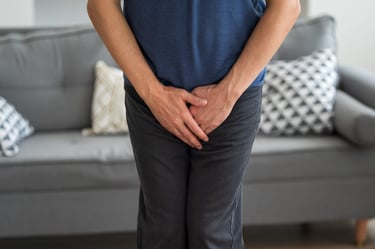Overactive Bladder


Overactive bladder or OAB is a complex problem that refers to the feeling of needing to urinate more often than the average person and sometimes includes urinary leakage. It is estimated that more than 33 million people are affected by overactive bladder. This condition can affect both men and women and should not be considered a normal part of aging.
Proper bladder function is a delicate balance between nerves and muscles. The nerves tell the bladder and muscles involved with urination when to relax and when to contract or squeeze. When these signals are balanced, the bladder will remain relaxed until it is full. Once full, nerves will send signals to the brain telling it the bladder is full allowing us to decide when and where it’s appropriate to urinate.
When that balance is upset there can be inappropriate communication between the bladder, brain, and muscles that can cause bladder problems such as:
Frequent urination results from an overactive nerve signal telling the brain the bladder is full when it is not. This is called urgency-frequency.
Leakage of urine often with a strong sense of urgency resulting from the bladder telling itself to empty when you are not ready for it to do so. This is called urge incontinence.
Inability to empty completely, sometimes resulting in the use of a catheter.
There are several effective therapies available for overactive bladder and my office offers a full spectrum of tests and treatments to find a beneficial solution for our patients.
STEPS to SUCCESS – Treating Overactive Bladder
Step 1
Bladder Satisfaction Survey
Discussion of history and symptoms
OAB* identified
Discuss Steps to Success and treatment options for OAB
Discuss behavioral modifications like diet change and timed voiding
Discuss pelvic floor exercises
A sample of an OAB medication can be tried for 2-4 weeks
Fill out a voiding diary for 3 days
Receive Educational Info (UDX**, InterStim brochure)
Step 2
Bladder Satisfaction Survey
Discuss results of Step 1: If successful, continue treatment. If not…Start Step 2
Urodynamics Consult
Cystoscopy Consult
Possible pelvic floor physical therapy referral
A 2nd sample of OAB medication can be tried for 2-4 weeks
Appts scheduled for Urodynamics, Cystoscopy, and follow-up
Step 3
Bladder Satisfaction Survey
Discuss results of Step 2: If successful, continue treatment. If not…Start Step 3
Discuss Urodynamics results
Consult InterStim Basic Evaluation Steps
Appts scheduled InterStim Basic Evaluation date
Step 4
Discuss InterStim Basic Evaluation results
If symptoms improve 50% or better then you’re a candidate for long-term therapy
If the trial is inconclusive, discuss Advanced InterStim Evaluation
Step 5
If the Trial/Advanced test is successful, Final Placement InterStim Therapy (1-2 weeks Post Trial)
If not successful, discuss other interventions


